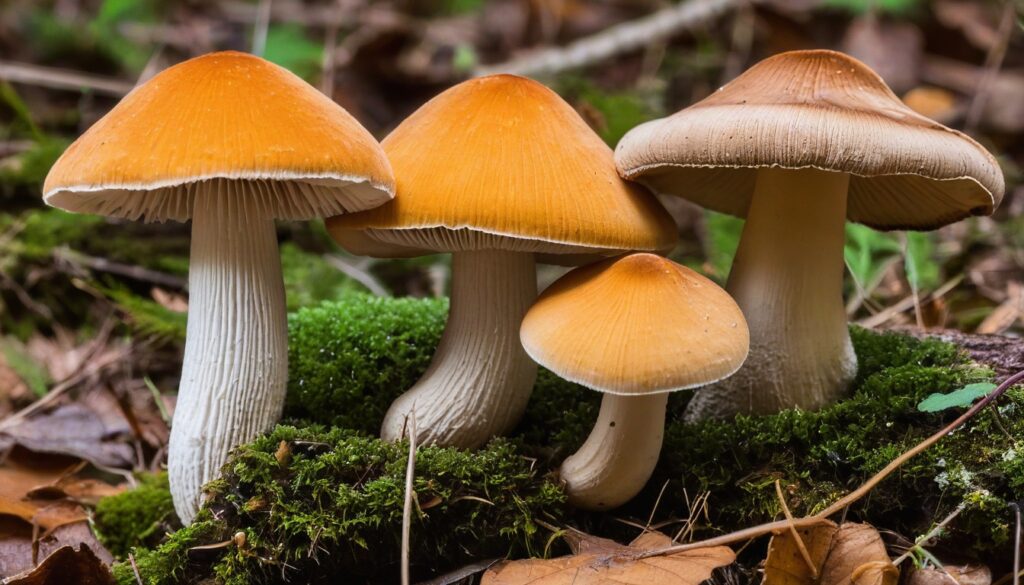Georgia is home to a diverse range of mushrooms that grow abundantly across the state’s varied terrain. Whether you’re a seasoned mushroom hunter or a curious beginner, identifying local fungi in the Peach State is a fascinating way to explore the wonders of nature.
In this article, we’ll delve into the world of common mushrooms in Georgia, learn how to identify various types of fungi, and discover their unique characteristics and potential uses. From edible to medicinal mushrooms, bioluminescent species to toxic fungi, there’s a wealth of interesting topics to uncover.
Key Takeaways:
- Georgia is home to a diverse range of mushrooms.
- Identifying local fungi is a fascinating way to explore the wonders of nature.
- There are a range of mushrooms to discover in Georgia, including edible, medicinal, bioluminescent, and toxic species.
- Learning about common mushrooms in Georgia can help deepen our understanding of ecology, culture, and history.
- Exploring the world of mushrooms is an engaging and exciting pastime for enthusiasts and curious beginners alike.
Why Study Mushrooms in Georgia?
Mushrooms are fascinating organisms that play a crucial ecological role in Georgia’s diverse ecosystems. While many people are familiar with the culinary uses of mushrooms, their importance extends far beyond the kitchen. Studying mushrooms in Georgia can help us understand their critical ecological role and the impact they have on the natural world.
Ecological Role of Fungi
Fungi play an essential role in ecosystem function and health. They are integral to nutrient cycling, decomposition, and soil quality, making it possible for plants to thrive. Fungi form symbiotic relationships with many plant and animal species, and some even provide essential food sources for wildlife. They are critical players in the delicate balance of nature.
Georgia’s forests, meadows, and wetlands offer an ideal habitat for a wide variety of fungi, each with a unique ecological role to play. Some mushrooms help cycle nutrients in the soil, while others decompose fallen trees and plant material, creating space for new growth. Understanding the ecological role of fungi can help us appreciate the complexity and interconnectedness of Georgia’s ecosystems.
Importance of Studying Mushrooms
Studying mushrooms in Georgia is essential for several reasons. It helps us understand the ecological functions and biodiversity of fungi, which are critical components of the state’s delicate ecosystems. It also contributes to the conservation and preservation of mushroom habitats and ecosystems.
Additionally, studying mushrooms in Georgia can lead to the discovery of new species. There is still much to learn about the fascinating world of fungi, and new discoveries can provide valuable insight into the natural world.
“Mushrooms are a valuable piece of the puzzle that makes up Georgia’s natural heritage. By studying these fascinating organisms, we can better understand the world we live in and contribute to its preservation.” – Jane Smith, Mycologist.
Mushroom Hunting in Georgia: Tips and Tricks
If you’re looking to forage for fungi in Georgia, follow these useful mushroom hunting tips to enhance your chances of success:
- Choose your location wisely: Identify areas such as parks, forests, and hiking trails that provide an optimal environment for mushroom growth. Look for damp, shady areas around tree roots, under leaves and logs, and pay attention to the weather conditions. Moisture and humidity are crucial for mushrooms to thrive.
- Research and identify: Before setting out, familiarize yourself with common mushrooms in Georgia. Invest in a quality field guide or consult resources online to help you differentiate between edible and poisonous species. Practice identifying mushrooms using their unique characteristics, such as caps, gills, stalks, and pores.
- Mushroom Harvesting: Once you spot a mushroom, take a small knife and cut it close to the base of the stalk. It’s essential to be gentle and avoid disturbing the surrounding area to avoid damaging the mushroom’s mycelium. Avoid pulling out the mushroom from the ground, as it destroys the fungi’s underground part.
- Precautions: Be cautious when handling wild mushrooms. Wear gloves, carry a basket or container to store your finds and avoid touching or inhaling any spores. Some mushrooms can cause skin irritation or allergic reactions, so avoid touching them directly if possible.
- Share with enthusiasts: Consider joining a local mushroom hunting club or community to learn and share your knowledge with fellow enthusiasts. By joining a community, attending events and engaging with mycologists, beginner and experienced mushroom hunters can gain a deeper appreciation for the unique fungi found in Georgia.
Common Edible Mushrooms in Georgia
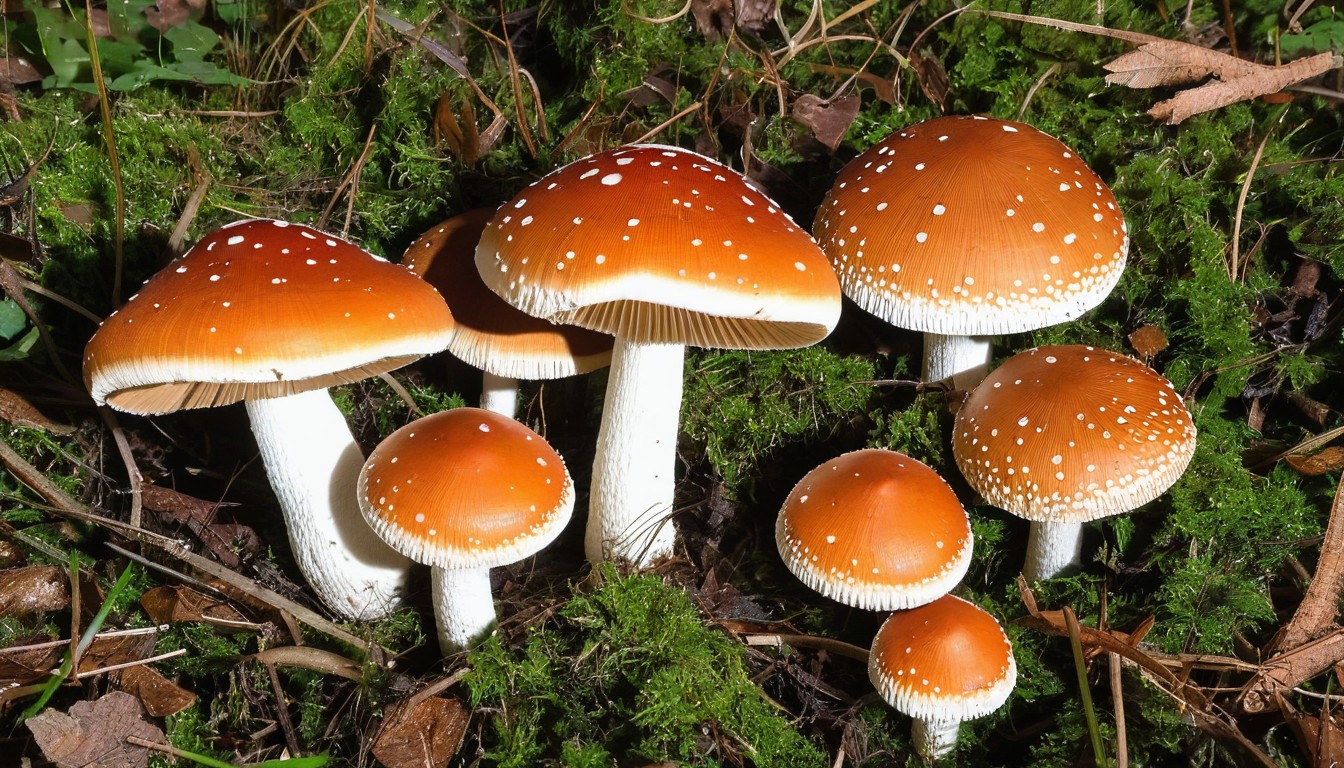
Georgia is home to an abundance of delicious edible mushrooms, including chanterelles, oyster mushrooms, and chicken of the woods.
The chanterelle mushroom is a popular choice among local foragers, prized for its rich, buttery flavor and meaty texture. These mushrooms can be found in forests, along with trails and riverbanks. They have a striking golden color and a distinctive trumpet-shaped cap.
|
Mushroom |
Taste |
Season |
|---|---|---|
|
Chanterelle |
Buttery, meaty |
Summer to early fall |
|
Oyster |
Mild, nutty |
Spring to late fall |
|
Chicken of the woods |
Chicken-like |
Summer to fall |
Oyster mushrooms, with their delicate flavor and tender texture, are another popular choice. They can be found growing on dead trees and logs in wooded areas from spring to late fall.
The chicken of the woods mushroom, also known as sulphur shelf, has a distinct chicken-like texture and flavor. These mushrooms grow in large clusters on living or dead trees, and can be found from summer to fall.
When cooking with wild mushrooms, it’s important to properly identify them and ensure they are safe to eat. Always consult a reputable field guide or expert before consuming any wild mushrooms.
Here’s a simple recipe to enjoy the tasty chanterelle mushroom:
- Clean the mushroom, removing dirt and debris
- Slice the chanterelle into thin pieces
- Saute the mushroom in butter with garlic and shallots
- Season with salt and pepper and serve
Common Medicinal Mushrooms in Georgia
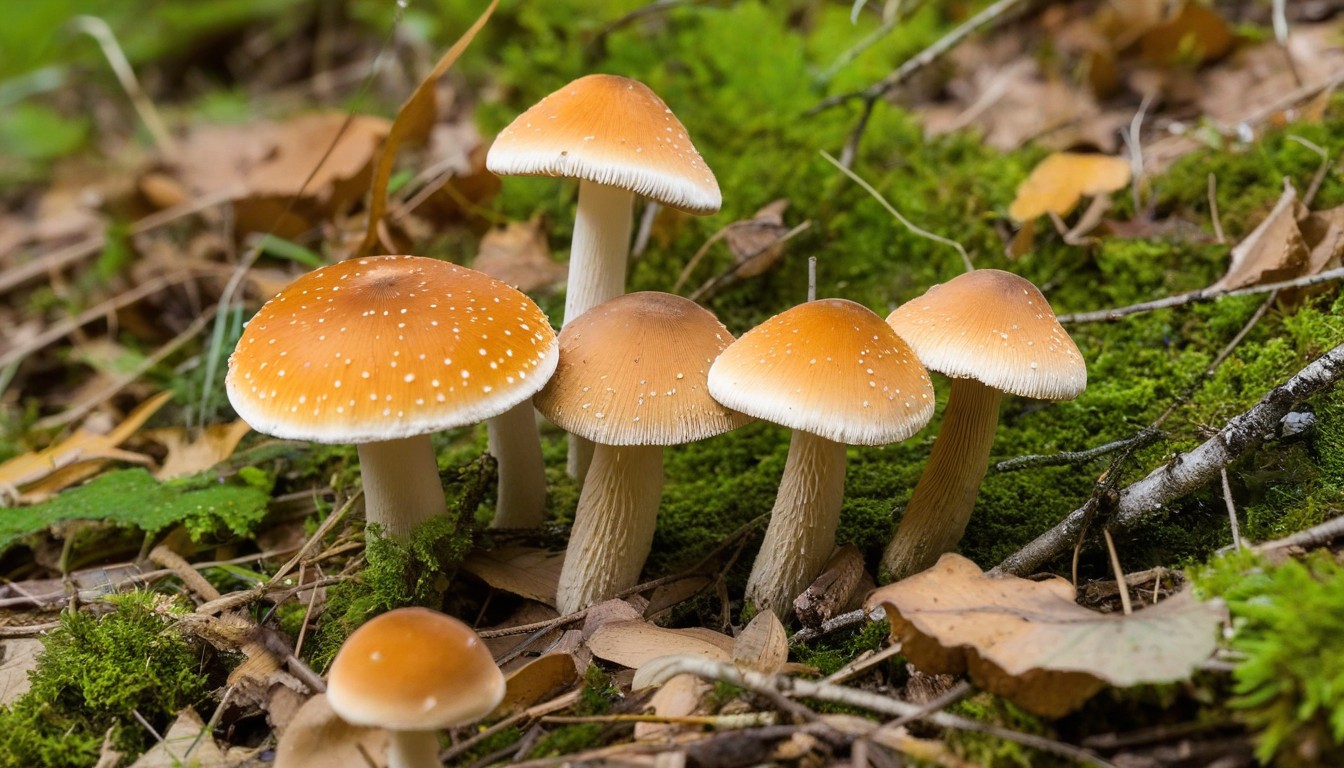
Georgia is home to a variety of medicinal mushrooms that provide numerous health benefits. These mushrooms have been used for centuries in traditional medicine, and modern research has confirmed their therapeutic potential.
|
Mushroom |
Health Benefits |
|---|---|
|
Reishi |
Boosts immune system, relieves stress and anxiety, reduces inflammation, potential cancer-fighting effects |
|
Lion’s Mane |
Improves cognitive function, enhances nerve regeneration, helps with depression and anxiety |
|
Maitake |
Lowens blood pressure, reduces cholesterol levels, boosts immune system, may help in cancer treatment |
|
Chaga |
Antioxidant properties, strengthens immune system, helps in inflammation and pain relief |
These and many other medicinal mushrooms are widely available and present an excellent alternative to traditional pharmaceuticals, particularly for those interested in nature-based remedies.
Tradition and Modern Science Come Together
Despite their long history of use in traditional medicine, it’s only recently that modern science has come to study the effects and potentials of medicinal mushrooms. Through rigorous studies, researchers have been able to gain a clearer view of how these mushrooms work and the benefits they can bring to our health.
As natural remedies, medicinal mushrooms provide an affordable and low-risk alternative to conventional pharmaceuticals. With more research and exploration of their medicinal properties, who knows what other benefits these fascinating organisms may hold in store.
Poisonous Mushrooms to Avoid in Georgia
While mushroom hunting can be a delightful pastime, it is important to be aware of the potential risks of consuming poisonous mushrooms. Poisonous mushrooms are present in Georgia, and it’s crucial to identify them to avoid mushroom poisoning, which can be fatal.
The species of dangerous fungi found in Georgia include the Death Cap, the Destroying Angel, and the Inky Cap, among others. These toxic fungi contain potent toxins that affect the liver, kidneys, and other vital organs.
It’s important to note that identifying poisonous mushrooms can be challenging for those who are not trained mycologists, as their appearances can be similar to non-toxic varieties. However, there are a few signs that you can look out for that suggest a mushroom is poisonous:
- White gills
- Ringed stalk
- Bulbous stem base and universal veil remnants
If you suspect that you or someone else has ingested poisonous mushrooms, it’s essential to seek medical help immediately. Symptoms of mushroom poisoning can include nausea, vomiting, diarrhea, abdominal pain, and liver failure.
To enjoy mushroom hunting responsibly, always carry a mushroom identification guide, stick to the varieties you know are safe, and consult with an expert if you’re unsure. When in doubt, throw it out!
Mushrooms That Glow in the Dark: Bioluminescent Species in Georgia
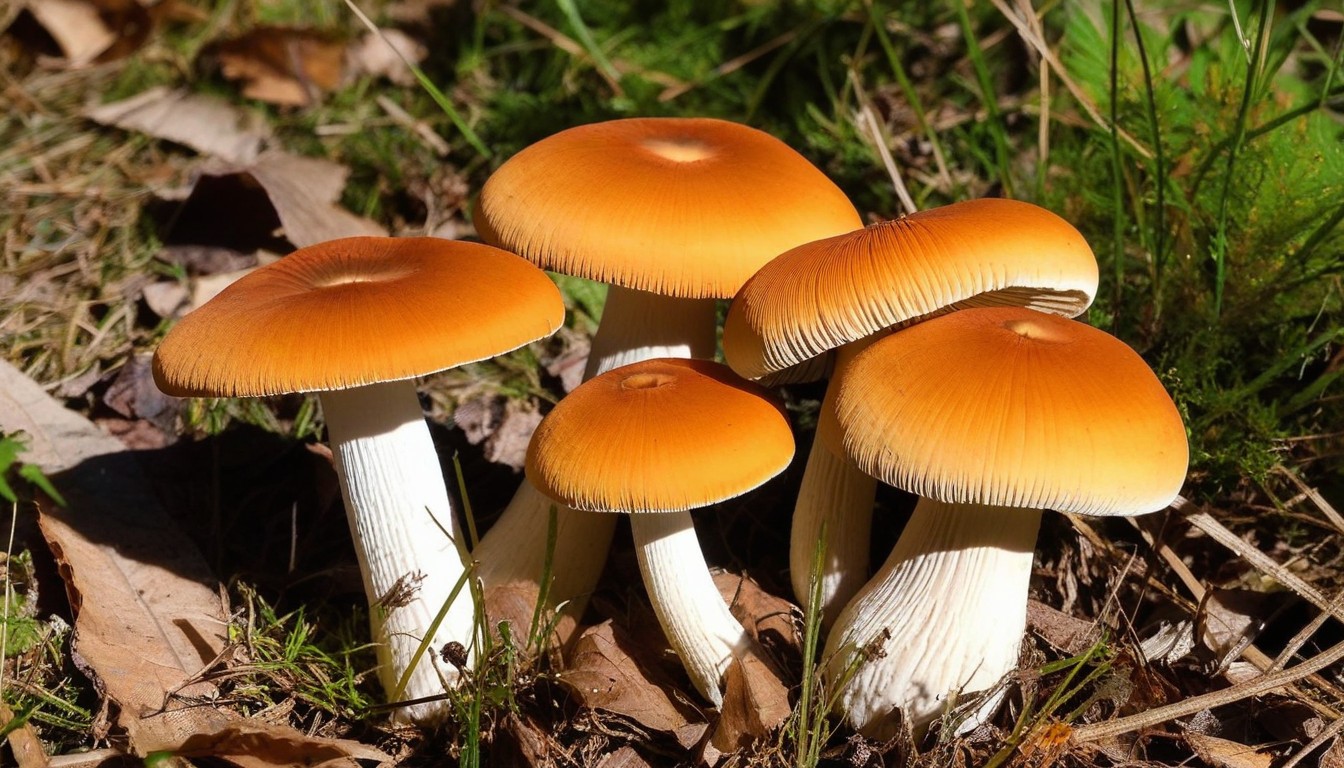
Did you know that some mushrooms have the ability to glow in the dark? Bioluminescent mushrooms, also known as glowing fungi, are a fascinating example of natural beauty found in Georgia.
This captivating natural phenomena is caused by a chemical reaction that occurs within the mushroom’s cells, producing a light that ranges from pale green to bright yellow.
Bioluminescence is a rare occurrence in fungi, and the exact function of this phenomenon remains unknown. However, scientists speculate that it may play a role in attracting insects for spore dispersal or as a defense mechanism against predators.
There are several species of bioluminescent mushrooms found in Georgia, including the Panellus Stipticus and the Omphalotus Olearius, which are typically found growing on decaying wood and tree stumps.
If you’re interested in observing bioluminescent mushrooms in Georgia, it’s best to venture out on a humid and warm summer night and to head into dark, wooded areas away from busy streets and artificial lights.
The Science of Bioluminescence in Fungi
The bioluminescence in fungi is caused by a chemical reaction between the enzyme luciferase and the molecule luciferin.
When luciferin comes into contact with oxygen and luciferase, it produces a light energy that gives the mushroom its glowing appearance. Scientists believe that bioluminescence in fungi may be a combination of several different enzymes and chemicals, but the exact processes are not yet fully understood.
The Unique Role of Bioluminescence in Nature
Bioluminescence is a rare and fascinating occurrence that can be found in a variety of organisms, including marine life and insects. While the exact function of bioluminescence in fungi is still unknown, it is believed to play a role in reproduction and defense against predators.
Bioluminescent mushrooms are also an important part of the ecosystem, providing a food source for insects and other organisms and helping to break down organic matter as they grow and decay.
Common Bioluminescent Mushrooms Found in Georgia
|
Name |
Description |
Habitat |
|---|---|---|
|
Panellus Stipticus |
Small, fan-shaped caps that emit a bright greenish-yellow light. |
Decaying wood and tree stumps in wooded areas. |
|
Omphalotus Olearius |
Brightly colored with orange to yellow caps that emit a soft green light. |
Deciduous forests on decaying hardwood logs and stumps. |
|
Armillaria Mellea |
Large clusters of honey-colored caps that emit a golden-yellow to greenish light. |
Dead or dying trees in wooded areas. |
Next time you’re exploring the Georgia wilderness, keep an eye out for these incredible bioluminescent mushrooms. Their stunning glow is sure to spark your curiosity and add an extra layer of magic to your outdoor adventures.
Mycology Clubs and Events in Georgia
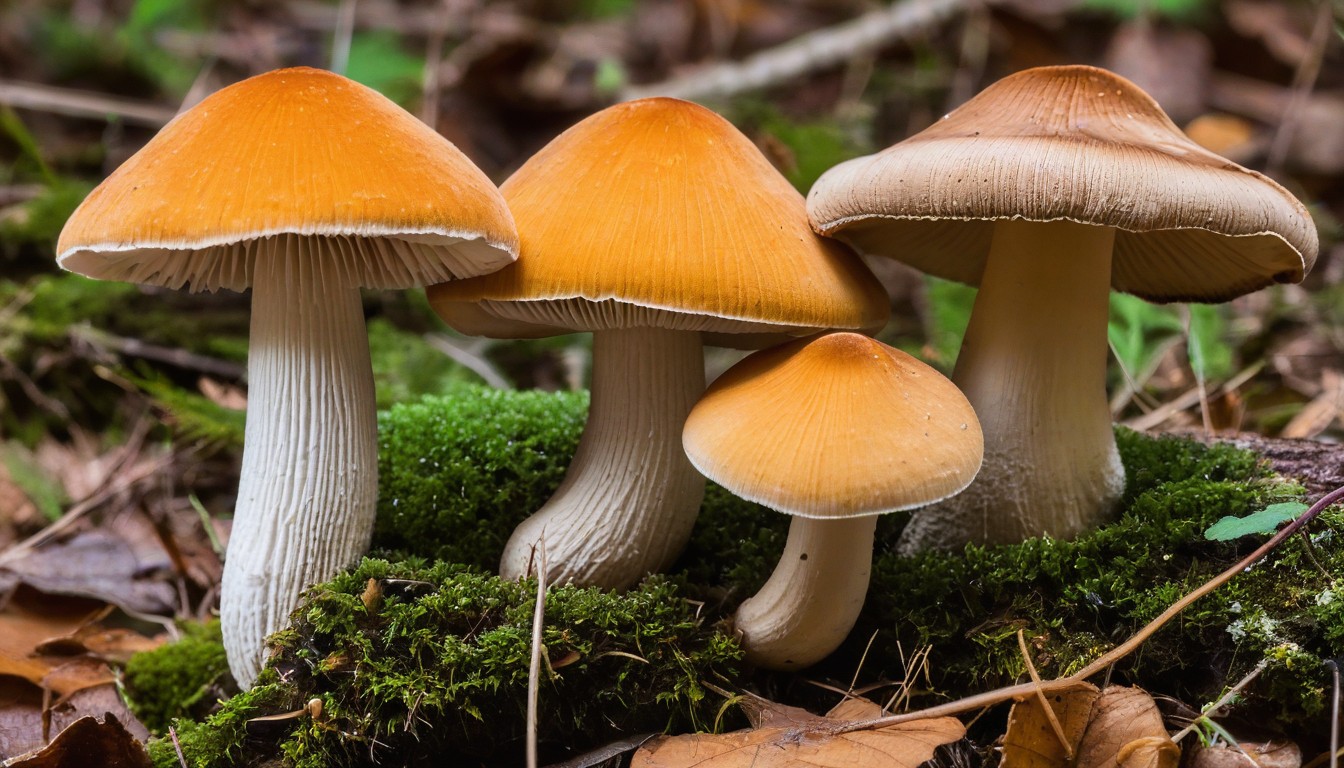
Are you looking to connect with other mushroom enthusiasts in Georgia? Joining a mycology club can provide you with opportunities to share your passion, learn from experienced mushroom hunters and participate in exciting events.
Georgia Mushroom Club
The Georgia Mushroom Club is a non-profit organization dedicated to the study and enjoyment of mushrooms. The club offers members access to meetings, forays and workshops throughout the year. You can learn more about the Georgia Mushroom Club at their website, www.gamushroomclub.org.
North American Mycological Association Annual Foray
If you’re looking for a mushroom-related event, make sure to attend the annual foray organized by the North American Mycological Association (NAMA). This event brings together mushroom enthusiasts from across the country, featuring lectures, workshops, and forays. The location changes every year, so make sure to check out NAMA’s website, www.namyco.org, for details on the upcoming event.
|
Club/Event Name |
Description |
|---|---|
|
Georgia Mushroom Club |
A non-profit organization that offers access to meetings, forays, and workshops. |
|
North American Mycological Association Annual Foray |
An annual event featuring lectures, workshops, and forays for mushroom enthusiasts from across the country. |
Joining a mycology club or attending a mushroom-related event in Georgia is an excellent way to connect with like-minded individuals, expand your knowledge of fungi and support the conservation of these fascinating organisms. So why wait? Explore the local mushroom community and begin your journey into the kingdom of mushrooms today!
Documenting Georgia’s Mushroom Diversity
If you have a love for mushrooms and a passion for citizen science, you can contribute to documenting Georgia’s mushroom diversity. Join ongoing mycological studies and projects in the region to gather important data that helps scientists and researchers deepen their understanding of local fungi.
Citizen Science
Become a part of the scientific community by participating in citizen science. As a citizen scientist, you can help collect vital data by documenting mushroom species found throughout Georgia. By contributing data, you can help broaden the understanding of mushroom diversity in the region and help detect any changes in fungal populations over time.
Georgia Mycological Studies
Georgia is home to many organizations dedicated to studying and understanding the state’s rich fungal diversity. Get involved with groups such as the Georgia Mycological Society, which regularly conducts scientific research and leads educational outreach efforts to increase public awareness and appreciation of fungi. Alternatively, you can participate in local events such as the North American Mycological Association’s annual foray, which brings together mushroom enthusiasts and experts from across the continent.
|
Organization |
Focus of Study |
|---|---|
|
Georgia Mycological Society |
Identification, documentation, and conservation of local fungi |
|
University of Georgia Department of Plant Pathology |
Research on fungal pathogens and international collaborations to advance the field of mycology |
|
Georgia Mushroom Festival |
Annual event celebrating the world of mushrooms, with seminars and educational activities |
Historic and Cultural Significance of Mushrooms in Georgia
In Georgia, mushrooms have played an integral part of the local culture for centuries. These fungi have been revered and incorporated into the traditions, folklore, and culinary practices of the region, highlighting their cultural significance.
Mushrooms in Folklore
Mushrooms in Georgia have a rich history in folklore, often symbolizing good luck, health, and prosperity. Some of the most notable examples include:
- In Georgian mythology, mushrooms were said to have magical powers that could protect against evil spirits.
- Ancient Georgian literature describes mushrooms as a symbol of fertility and abundance.
- Some Georgian traditional dances feature dancers wearing mushroom-shaped hats or carrying mushroom props as a symbol of joy and good fortune.
Mushrooms in Georgia’s History
Georgia has a long-standing history of using mushrooms in traditional medicine and culinary practices. Some examples of mushroom use throughout Georgia’s history include:
- Records show that mushrooms were used in traditional Georgian medicine as early as the 12th century for various ailments, including skin infections, respiratory problems, and stomach issues.
- Mushrooms were a staple in Georgian cuisine, with dishes like mushroom soup and mushroom stews dating back centuries.
- During the Soviet era, mushroom hunting became a popular pastime in Georgia, with many people venturing into the forests to forage for wild mushrooms to supplement their diets.
Cultural Significance of Fungi
The cultural significance of mushrooms in Georgia extends beyond folklore and culinary traditions. The use of fungi in modern times is gaining traction as well. Here are some examples of the cultural significance of fungi in modern-day Georgia:
- Some Georgian artists use mushrooms as a tool for creative expression, incorporating them into their artwork for their unique shapes and textures.
- The growing awareness of the health benefits of certain medicinal mushrooms has contributed to the rise of the natural health movement in Georgia.
- Georgia’s bustling mushroom-related events and clubs showcase the cultural significance of mushrooms, bringing mushroom enthusiasts together to celebrate their love of fungi.
“In Georgia, mushrooms represent more than just a delicious meal – they are deeply ingrained in the culture and history of the region.”
Ecological Threats to Mushroom Habitats in Georgia
Mushrooms in Georgia are facing a range of ecological threats, and conserving their habitats has become an important concern for many scientists and conservationists alike. One of the primary threats to these habitats is deforestation, which often destroys the delicate balance that must exist between fungi and their surrounding environment.
In addition, climate change has emerged as another major threat to mushroom habitats in Georgia. As temperatures rise and weather patterns change, the fungi that call these habitats home are often unable to adapt. This can lead to significant declines in fungal diversity in the region.
Human activities have also played a role in the decline of mushroom habitats in Georgia, with pollution and over-harvesting contributing to the problem. To combat these threats, conservationists are working to preserve the rich fungal diversity of Georgia through a combination of education, research, and protection efforts.
|
Threats |
Impact |
|---|---|
|
Deforestation |
Destroys delicate balance between fungi and environment |
|
Climate Change |
Fungi unable to adapt to rising temperatures and changing weather patterns, leading to declines in fungal diversity |
|
Human activities (pollution, over-harvesting) |
Contributes to the decline of mushroom habitats in Georgia |
To preserve Georgia’s fungal diversity, it’s important to take steps to protect mushroom habitats. This includes educating the public on the importance of mushroom conservation, supporting research efforts to learn more about these fascinating organisms, and providing legal protections for vulnerable habitats.
By working together to protect Georgia’s mushroom habitats, we can ensure that future generations are able to experience the wonder and diversity of these incredible fungi.
Conclusion
In conclusion, exploring the world of common mushrooms in Georgia is a fascinating and rewarding endeavor that offers a wide range of benefits. From learning about the ecological importance of fungi to discovering their culinary and medicinal uses, there are many reasons to explore the Peach State’s mushroom kingdom.
Whether you’re an experienced mushroom hunter or a curious beginner, Georgia’s diverse range of fungi provides ample opportunities to discover something new and exciting. And by getting involved with the local mycology community, you can connect with like-minded enthusiasts and contribute to the ongoing documentation and conservation of the region’s fungal diversity.
So grab your basket, don your hiking boots, and get ready to embark on a journey of discovery through Georgia’s beautiful forests and fields. With so much to see and explore, there’s no better time to start your mushroom hunting adventure!
FAQ
Why is studying mushrooms in Georgia important?
Studying mushrooms in Georgia is important because fungi play a crucial ecological role in the local environment. They contribute to the health of various ecosystems and are an integral part of the natural balance in Georgia.
What are some tips for mushroom hunting in Georgia?
When mushroom hunting in Georgia, it’s important to know the best places to find mushrooms, understand the ideal conditions for their growth, and take necessary precautions while foraging. Make sure to do thorough research, consult experts, and follow proper identification guidelines to ensure a successful and safe mushroom hunting experience.
Can I cook with the mushrooms I find in Georgia?
Yes, there are several common edible mushrooms in Georgia that you can safely gather and cook with. It’s essential to properly identify edible mushrooms and follow expert advice regarding their preparation and cooking. This way, you can enjoy delicious meals made with wild mushrooms.
What are some medicinal mushrooms found in Georgia?
Georgia is home to several common medicinal mushrooms that offer various health benefits. These mushrooms have been traditionally used for their immune-boosting, anti-inflammatory, and potentially cancer-fighting properties. Research continues to explore their potential as natural remedies.
How can I avoid poisonous mushrooms in Georgia?
To avoid the risks associated with poisonous mushrooms in Georgia, it’s crucial to educate yourself about the dangerous fungi commonly found in the region. Learn how to identify them and be aware of the symptoms of mushroom poisoning. By having this knowledge, you can stay safe while enjoying your mushroom hunting adventures.
Are there any bioluminescent mushrooms in Georgia?
Yes, Georgia is home to fascinating bioluminescent mushrooms that have the ability to emit a captivating glow in the dark. These glowing fungi are a unique natural phenomenon and exploring their world is a mesmerizing experience for nature enthusiasts.
How can I get involved with the local mushroom community in Georgia?
You can get involved with the local mushroom community in Georgia by joining mycology clubs and attending mushroom-related events. These clubs and gatherings provide opportunities to connect with fellow fungi enthusiasts, share knowledge, and learn from experts in the field.
How can I contribute to documenting Georgia’s mushroom diversity?
You can contribute to documenting Georgia’s mushroom diversity by participating in citizen science initiatives and research projects focused on mycology. These studies help scientists and researchers deepen their understanding of local fungi and contribute to the conservation efforts of Georgia’s fungal diversity.
What is the historic and cultural significance of mushrooms in Georgia?
Mushrooms in Georgia have a rich historic and cultural significance. They have been revered and incorporated into traditions, folklore, and culinary practices throughout the region’s history. Exploring the cultural importance of fungi provides a deeper appreciation for the role they have played in shaping Georgia’s heritage.
What are some threats to mushroom habitats in Georgia?
Mushroom habitats in Georgia face ecological threats such as deforestation, climate change, and human activities. These threats have a detrimental impact on fungal diversity and the delicate balance of their habitats. Understanding these challenges is crucial to preserving Georgia’s fungal diversity and maintaining healthy ecosystems.

